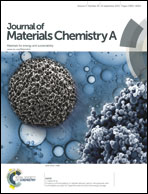Sulfur loaded in curved graphene and coated with conductive polyaniline: preparation and performance as a cathode for lithium–sulfur batteries†
Abstract
We report a composite (CG-S@PANI), sulfur (S) loaded in curved graphene (CG) and coated with conductive polyaniline (PANI), as a cathode for lithium–sulfur batteries. CG is prepared by splitting multi-wall carbon nanotubes and loaded with S via chemical deposition and then coated with polyaniline via in situ polymerization under the control of ascorbic acid. The physical and electrochemical performances of the resulting CG-S@PANI are investigated by nitrogen adsorption–desorption isotherms, X-ray powder diffraction, thermogravimetric analysis, transmission electron microscopy, electrochemical impedance spectroscopy, charge–discharge tests, and electronic conductivity measurements. CG-S@PANI as a cathode for lithium–sulfur batteries delivers an initial discharge capacity of 851 mA h g−1 (616 mA h g−1 on the basis of the cathode mass) at 0.2 C with a capacity retention of over 90% after 100 cycles. This nature is attributed to the co-contribution of CG and conductive PANI to the concurrent improvement in electronic conductivity and chemical stability of the sulfur cathode.


 Please wait while we load your content...
Please wait while we load your content...